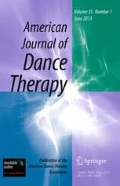This June 2013, Volume 35 Number 1 of AJDT, is an inclusive issue compiled with material from the 47th annual conference of the American Dance Therapy Association such as the Marian Chace Lecture and Introduction, Research Poster Abstracts, and International Panel Presentations. The issue also features two book reviews and two original research articles.
The issue begins with material from the conference, “Exploring Vistas and Soaring to New Heights: DMT 2012 and Beyond,” held in Albuquerque, New Mexico, 11–14 October, 2012. First, we feature Dr. Judith Bunney’s Marian Chace Foundation lecture, Honoring History and Heritage: Roots for New Heights with Introduction by Dr. Irma Dosamantes-Beaudry.
Next, panelists describe the intriguing global panorama of new directions occurring in the field of dance/movement therapy in the 18th annual international panel article. Perspectives from Australia, Estonia, Germany, India, Japan, Czech Republic, China, and The Netherlands are presented.
The Research Poster Session Abstracts printed in this issue highlight the expanding research developments and implications for dance/movement therapy. Topics such as medical dance/movement therapy for breast cancer survivors and its influence on body image and quality of life, the psychology of the embrace, outcomes from a creative arts therapy summer camp, and other population-specific studies examining autism, Parkinson’s Disease, and developmental disabilities are shared.
Next, the original research study, Tango Dance Can Reduce Distress and Insomnia in People with Self-Referred Affective Symptoms by Rosa Pinniger, Einar Thorsteinson, Rhonda Brown, and Patricia McKinley suggests that the dance form of tango, more so than meditation or exercise, can serve as a therapeutic approach to help individuals with psychological disorders to achieve greater self-expression, a goal that is of particular interest to dance/movement therapists.
April Betty’s proposed theoretical framework, Taming Tidal Waves, examines the question of how dance/movement therapy might be applied to support the development of emotion regulation in maltreated children, specifically in the context of residential treatment centers.
Two book reviews and Of Note, an annotated bibliography of recent media and publications of interest to dance/movement therapy, complete this issue.
As Co-editors, we thank the authors for their contributions to this issue and are encouraged by the continued development of dance/movement therapy research and the expansion of clinical practice. We invite and look forward to submissions that continue to support this development.
Author information
Authors and Affiliations
Corresponding author
Rights and permissions
About this article
Cite this article
Devereaux, C., Loman, S. Editorial. Am J Dance Ther 35, 1–2 (2013). https://doi.org/10.1007/s10465-013-9154-1
Published:
Issue Date:
DOI: https://doi.org/10.1007/s10465-013-9154-1

